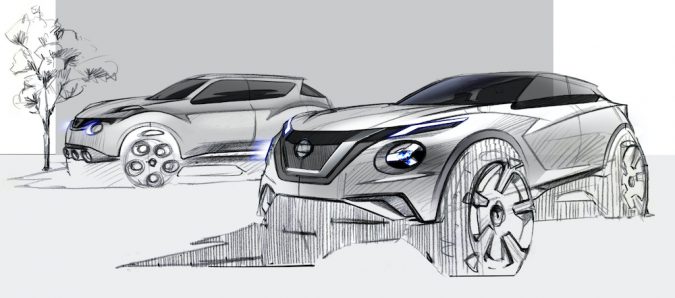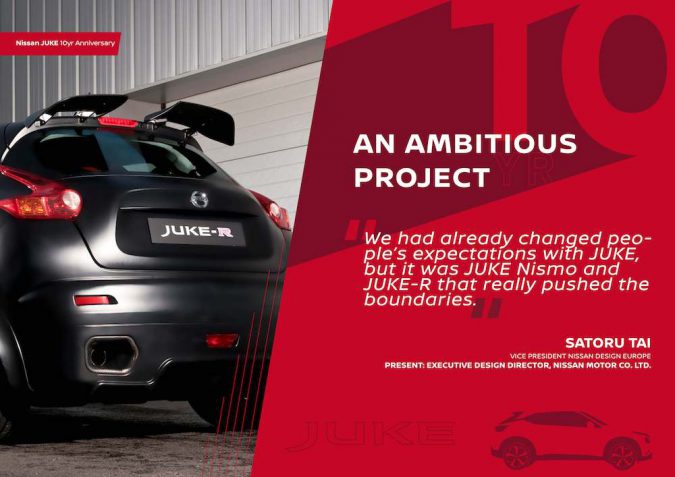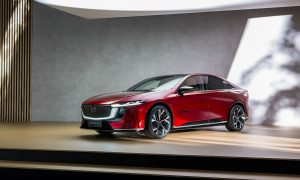Concept cars don’t often make it into production. Sure they’re an exciting vision of the future but real cars have to be approved by accountants and safety regulators. By the time a production car reaches the showroom, the best parts of the concept car have usually disappeared.
Not so with the Nissan Juke. The Juke, which celebrates 10 years of production this year, is almost a mirror image of the Qazana – Nissan’s futuristic concept car unveiled at the Geneva Motor Show in 2009. With its cocoon body, enormous wheel arches, high waistline and narrow side windows, the Qazana was part-Jetsons space car, part-hatchback and part-racer.
A review in Auto Express magazine at the time heaped praise on the Qazana, claiming that “as concept cars go, it doesn’t get much better than this!” The excitement was palpable not just, the magazine explained, because the car was “stunning to look at” but because it was also a “production reality!”
A Pioneer
The design of the Nissan Juke was always intended to be revolutionary. The then Vice President of Nissan Design Europe, Alfonso Albaisa, recalls that “there was no reference for us to work from but creative seeds emerged rather quickly and powerfully right off the bat. We knew we wanted to create something fundamentally different and not just a smaller version of the Qashqai.”
And Nissan succeeded. Because up until that point no-one had really done a miniature and sporty SUV. Certainly not with that styling. The Juke’s nearest competitor, the Toyota RAV4, was no sports car. And the Ranger Rover Sport was too chunky, too expensive and too much of an off-roader.
The Juke was new because it was a crossover vehicle that matched the ride height of an SUV with the spirit of something more petite. The number of micro SUVs on the market today, from the Peugeot 2008 to the Mazda CX-30, all owe their existence to this Japanese pioneer.
The Inspiration
But the production of the Juke wasn’t a given. It was only the success of the Qashqai that had given Nissan the confidence to be bold with the Juke. The Regional Product Manager for Nissan at the time, Emanuele Berlenghi, explains “we said we should aim to replicate the success of the Qashqai, but in the B-segment. But we all agreed we should not do a simple replica. The whole challenge for the European team was to reinvent the idea and bring a new proposition to the market.”
In other words, it would have to be unique. Matthew Weaver worked as Senior Exterior Designer for the Juke. He says “I was on the train one day and remembered seeing a young man in a flat cap with a diamond skull on it, a bright t-shirt, a pinstripe jacket and trainers. It was an eclectic mix, but I thought: if people don’t have to conform, why should cars? Different is good, it stands out. That is exactly what we wanted to achieve with Juke.”
An Unconventional Design
The concept car on paper shows a vehicle low on its haunches with a streamlined body that looks almost like a two-door coupé. Publicity images of the interior are no less radical with a centre console inspired by a motorcycle fuel tank and dashboard instruments housed in twin binnacles more suited to an airplane cockpit.
The Juke went into production retaining most of the Qazana’s distinctive elements. More than 50,000 orders were received within 4 months of the car’s launch and Europe alone recorded more than 30,000 pre-orders. A pleasant surprise given that the Yokohama-based firm had only aimed for 1,300 sales a month. Within the next decade, Nissan will sell more than 1.5 million Jukes to customers around the world.
The Juke with More Power – the Juke Nismo and Juke Nismo RS
The Juke was just the starting point for Nissan. It continued to push boundaries with the introduction of the Juke Nismo in 2013 (Nismo being Nissan’s motorsports division) and the more powerful Juke Nismo RS the following year.
The Juke Nismo was transformed by the 550 bhp power train taken from Nissan’s GT-R supercar. Satoru Tai, who worked on the Nismo RS as Vice President of Nissan Design Europe, says “if we exceeded people’s expectations with the Juke Nismo, they were blown away by what we did with the Juke-R… With Juke-R we put the GT-R engine and handling components into a performance-optimised JUKE body. It was an incredible design challenge, to combine those two worlds, but we produced a head-turning crossover with supercar performance.”
What Next?
Are there any more boundaries to push on the Juke’s 10th anniversary? Nissan answered that question with the second-generation Juke, launched in October 2019.
The new Juke retains many of the same characteristic features of its older stablemate – the overly large wheel arches, the exaggerated streamlined windows – but the front grille is more aggressive and the sidelights are sharper and more defined.
The interior is different too with more sophisticated trim, a new dashboard layout and new technology. It is more refined overall. It is what Nissan was aiming for.
The Vice President of Product Planning at Nissan, Marco Fioravanti, explains “following the success of the first JUKE, we knew the second-generation JUKE needed to elevate the boldness and the customer experience even more. We worked hard to retain the same pioneering energy, but evolve it to be more ‘grown up’. It’s just as distinctive, but it’s more spacious, offers the advanced NissanConnect infotainment system and has a high-quality feel.”
Ten years on, the concept-turned-production car that shook the world is still going strong. Other automobile manufacturers take note: sometimes it really does pay to be bold. 












